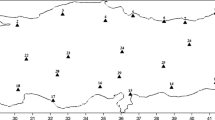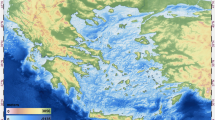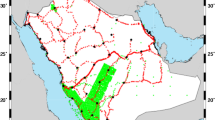Abstract
It is considered that precise geoid determination is one of the main current geodetic problems in Turkey since GPS defined coordinates require geoidal heights in practice. In order to determine the geoid by least squares collocation (LSC) the area covering Turkey was divided into 114 blocks of size 1° × 1°. LSC approximation to the geoid based upon the tailored geopotential model GPM2-T1 is constructed within each block. The model GPM2-T1 complete to degree and order 200 has been developed by tailoring of the model GPM2 to mean free-air anomalies and mean heights of one degree blocks in Turkey. Terrain effect reduced point gravity data spaced 5′ × 5′ within each block which the sides extended 0°.5 were used in LSC. Residual terrain model (RTM) depends on point heights at 15″×20″ griding and 5′×5′ and 15′×15′ mean heights has been carried out in terrain effect reduction. Indirect effect of RTM on geoid is also taken into account. The geoid, called Turkish Geoid 1991 (TG-91), referenced to GRS-80 ellipsoid has been computed at 3′ × 3′ griding nodes within each block. The quality of the TG-91 is also evaluated by comparing computed and GPS derived geoidal height differences, and 2.1 – 2.6 ppm accuracy for average baseline lenght of 45 km is obtained.
Similar content being viewed by others
References
Andrews, D.F., P.J. Bickel, F.R. Hampel, P.J. Huber, W.H. Rogers, J.W. Tukey (1972): Robust estimates of Location. Princeton University Press, Princeton, New Jersey.
Arabelos, D., (1989): Gravity field approximation in the area of Greece with emphasis on local characteristics. Bull. Geod. Vol. 63. No.1, pp. 69–84.
Arabelos, D., P.Knudsen, C.C.Tscherning (1987): Covariance and bias treatment when combining gravimetry, altimeter and gradiometer data by collocation. XIX General Assembly IUGG, Vancouver.
Ayan, T.(1976): Astrogeodatische Geoidberechnung für das Gebiet der Turkei. Karlsruhe.
Ayhan, E. (1991): Local geoid determination by least squares collocation. Harita Dergisi, No. 106, pp. 91–110 (In Turkish).
Ayhan, E. E. Bank, O. Lenk, A. Jeker (1987): South-Western Anatolia (Aegean Region) Doppler geoid. Bolletino di Geod. e Sci. Aff. Anno XLVI, No. 4, pp.293–308.
Denker, H., W.Torge, H.-G. Wenzel, D. Lelgeman, G. Weber (1986): Strategies and requirements for a new European geoid computations. Proc. of the Int. Syp. on the Definition of the Geoid, May 26–30, Florence.
Denker, H., H.-G. Wenzel (1987): Local geoid determination and comparison with GPS results. Bull. Geod., Vol.61, No.4, pp.349–366.
Engelis, T., R.H. Rapp, C.C. Tscherning (1984): The precise computations of geoid undulation differences with comparison to results obtained from the global positioning system. Geophy. Res. Lett., Vol.11, No.9, pp. 821–824.
Engelis, T., R.H.Rapp, Y.Bock (1985): Measuring orthometric height differences with GPS and gravity data. Manuscripta Geodaetica, Vol.10, No.3, pp. 187–194.
Forsberg, R.(1984): A study of terrain reductions, density anomalies and geophysical inversion methods in gravity field modelling. OSU, Dept. of Geod. Sci., Rept. No. 355, Columbus.
Forsberg, R., F.Madsen (1981): Geoid prediction in nothern Greenland using collocation and digital terrain models. Anns. Geophys., Vol. 37, No.1, pp.31–36.
Forsberg, R., C.C.Tscherning (1981): The use of height data in gravity field approximation by collocation. JGR, Vol. 86, No. 89, pp. 7843–7854.
Forsberg, R., F.Madsen (1990): High-precision geoid heights for GPS levelling. Presented at GPS-90 Sym., Ottawa.
Forsberg R., A.H.W. Kearsley (1990): Precise gravimetric geoid computations over large regions. (In: Developments in Four — Dimensional Geodesy. Eds. F.K. Brunner, C. Rizos, Springer Verlag).
Goad, C.C., M.M. Chin, C.C. Tscherning (1984): Gravity empirical covariance values for the continental United States. JGR, Vol.89, No. 89, pp. 7962–7968.
Gürkan, O. (1978): Astrogeodetic network distortions and Turkish first order triangulation network. KT, Trabzon (In Turkish).
Kearsley, A.H.W., (1988): Tests on the recovery of precise geoid height differences from gravimetry. JGR, Vol. 93, No. 86, pp.6559–6570.
Kearsley, A.H.W., M.G. Sideris, J.Krynski, R.Forsberg, K.P.Schwarz (1985): White sands revisited. A comparison of techniques to predict deflections of the vertical. UCSE, Rept. No. 3007, Calgary.
Kearsley, A.H.W., R. Forsberg (1990): Tailored geopotential models applications and shortcomings. Manuscripta Geodaetica, Vol. 15, No.3, pp.151–158.
Knudsen, P. (1987): Estimation and modelling of the local empirical covariance function using gravity and satellite altimeter data. Bull. Geod., Vol. 61, No. 2, pp 145–160.
Knudsen, P. (1989): Determination of local empirical covariance functions from residual terrain reduced altimeter data. OSU, Dept. of Geod. Sci., Rept. No. 395, Columbus.
Lachapelle, G., C.C. Tscherning (1978): Use of collocation for predicting geoid undulations and related quantities over large areas. Proc. of the Int. Sym. on the geoid in Europe and Mediterranean Area, Ancona, pp. 133–152.
Moritz, H. (1980): Advanced physical geodesy. Herbert Wichmann Verlag, Karlsruhe.
Rapp, R.H. (1986): Global potential solutions. (In: Mathematical and numerical techniques in physical geodesy. Ed.H.Sünkel, Springer Verlag, pp.365–415).
Rapp. R.H., M.Kadir (1988): A preliminary geoid for the state of Tennesse. Surveying and Mapping. Vol. 48, No.4, pp.251–260.
Schwarz, K.P. (1985): Data types and their spectral properties. (In: Local gravity field approximation. Ed.K.P. Schwarz, UCSE, Pub. 60003, pp.1–66).
Schwarz, K.P, G.Lachapelle (1980): Local characteristic of the gravity anomaly covariance function. Bull. Geod., Vol. 54, No.1, pp.21–26.
Schwarz,K.P, M.G. Sideris (1985): Precise geoid heights and their use in GPS-interferometry. Geodetic survey of Canada, Dept.of Energy, Mines and Resources, Ottowa.
Schwarz, K.P., M.G.Sideris, R.Forsberg (1987): Orthometric heights without levelling Jour. of Surv. Eng., Vol. 113, No.1, pp. 28–40.
Sideris, M.G., K.P.Schwarz (1986): Improvements of medium and short wavelength features of geopotential solutions by local data. Proc. of the Int. Syp. on the Definition of the Geoid, 26–30 May, Florence.
Sünkel, H. (1979): A covariance approximation procedure. OSU, Dept. of Geod. Sci., Rept. No. 286, Columbus.
Sünkel, H., N.Bartelme, H.Fuchs. M.Hanafy, W. D.Schuh, M.Wieser (1987): The gravity field in Austria. IUGG XIX General Assembly, Proc. of the IAG Sym. Vol.2, pp. 475–503.
Torge, W., T.Basic, H.Denker, I.Dolift, H.- G.Wenzel(1989): Long range geoid control throught the Europen GPS traverse. DGK, Reihe B, Heft Nr.290.
Tscherning, C.C. (1974): A Fortran IV program for the determination of the anomalous potential using stepwise least squares collocation. OSU, Dept. of Geod. Sci., Rept. No. 212, Columbus.
Tscherning, C.C. (1981): Comparison of some methods for the detailed representation of the Earths gravity field. Rev. Geophys. Space Phys., Vol. 19, No.1, pp.213–221.
Tscherning, C.C. (1982): Geoid determination for the Nordic Countries using collocation. Proc. of the IAG General Meeting, Tokyo, pp. 472-483.
Tscherning, C.C. (1985): Local approximation of the gravity potantial by least squares collocation (In: Local gravity field approximation. Ed. by K.P. Schwarz, UCSE, Pub. 60003, pp. 277–261).
Tscherning, C.C., R.H. Rapp (1974): Closed covariance expressions for gravity anomalies, geoid undulations, and deflections of the vertical implied by anomaly degree variance models. OSU, Dept. of Geod. Sci. Rept. No. 208, Columbus.
Tscherning, C.C., R.Forsberg (1987): Geoid determination in the Nordic Countries from gravity and height data. Boll. Sci. Aff., 46, No. 1, pp. 21–43.
Tziavos, I.N. (1987): Determination of geoidal heights and deflections of the vertical for the Hellenic area using heterogenous data. Bull. Geod. Vol. 61, No.2, pp.177–197.
Vanicek, P., A.Klausberg (1987): The Canadian geoid Stokesian approach. Manuscripta Geodaetica, Vol.12, No.2, pp.86–98.
Weber, G., H.Zomorrodian (1988): Regional geopotantial model improvement for the Iranian geoid determination. Bull. Geod. Vol. 62, No.2, pp.125–145.
Wenzel, H.-G. (1985): Hochauflπsende Kugelfunktionsinodelle für das Gravitationspotantial der Erde. Wiss. Arb. Der Fachrichtung Vermessungwesen der Universitat Hannover, No. 137, Hannover.
Author information
Authors and Affiliations
Rights and permissions
About this article
Cite this article
Ayhan, M.E. Geoid determination in Turkey (TG-91). Bulletin Geodesique 67, 10–22 (1993). https://doi.org/10.1007/BF00807293
Received:
Accepted:
Issue Date:
DOI: https://doi.org/10.1007/BF00807293




